
Last month there was a terrible tragedy on Manaslu which we reported here.
We have received two perspectives on this tragedy; first is an account from Greg Hill, who was on the mountain at the time; the entry from his blog makes sobering reading. The second piece is from Alison Culshaw and is her tribute to Rémy Lécluse who died in the avalanche.
Disaster on Manaslu - Greg Hill
I am not really even sure where to start. I will begin part way through our expedition.
We were getting acclimatized and moving quickly up to around 7000m on Mt Manaslu. As our group toured higher they encountered loud whummfing sounds - a settling of the snowpack that indicates a weak bottom layer. At this point it was simply an indication of weakness that would get worse with a heavier load.... We turned around and skied down, experiencing amazing skiing at the highest elevation I have ever skied.
For 10 days we weathered rain and snow, day after day of it. So the upper mountain was getting loaded with the weight of new snow. When it finally cleared it was obvious that most of the mountain had gone through many avalanche cycles. There were crown lines, and avalanche debris everywhere, though the slopes that we needed to climb had not slid. We waited a few more days for the snow to stabilize some more before venturing onto them.
A bit of a backstory is needed... Tibet's borders are closed to expeditions this year and most expeditions have re located to Manaslu. That's why we ended up here. Our plans for Cho-Oyu were canceled and our ski objective became the eighth highest mountain in the world. We arrived on Sept 6th and watched basecamp grow into over 300 climbers and 200 sherpa. More climbers than this place has ever seen in a season. It seemed ripe for a catastrophe of sorts.
On our way up on Sept 22nd, we could see a line up of climbers on the fixed ropes, a traffic jam moving slowly through the seracs. Easily over a hundred people on their way up to Camp 2. We were coming late so we could avoid this and get up to our Camp 2.
When I first saw the traditional Camp 2 placement I knew that there was no way I would camp there. Sitting under the imposing face of Manaslu, I would never be able to sleep knowing how much avalanche terrain was above me. It was a campsite that has proven to be safe over the years, but given the right conditions it could get hit by a large avalanche. We searched and finally placed our Camp 2 off to the side. Perched on an ice shelf, it was as "safe" as we could find, a small elevated bit of terrain away from the main flow from the face.
On Sept 22nd, we arrived at our camp 2, I looked up and saw many tents camped at 6800m directly in the center of the slope, Camp 3. I worried about this but could not do anything about it.
We went to bed thinking we may try for the summit the next day, depending on how the snow had stabilized. Which is information we would get ascending the slope the next day. The stability could go either way: the new snow could have compressed the weak layer and bridged any weakness, allowing for safe travel; or the new snow, combined with the wind could have created a slab of snow sitting precariously on this weak basal layer...
It turned out to be exactly that. At 4:45 am the cold temperatures created some brittle seracs, which broke off from the glacier at 7400m and landed on the wind slabbed snow, giving it enough of a trigger to crack approximately 300m across the slope. This avalanche swept through Camp 3 catching everyone sleeping in their tents and wrapped in their bags. At least 16 tents were swept off their platforms and sent careening down the mountainside.
The blast of wind from the avalanche sent our tents flapping and soon enough we could hear people yelling for each other. Lights from headlamps accompanied many voices and we knew that disaster had struck.
Skinning up, our headlamps lit up a down boot, and we knew that the tents had been hit. Tents, clothes, sleeping bags, lone boots, everything lay partially buried everywhere. Within minutes we were helping people get warm and digging others out of the snow. It was hard to tell how many people where involved so we focused on those that where above the snow. Knowing that those who were buried had very little chance of surviving.
The variety of injuries was astounding, some people were "OK" from their 1000 foot tumble, others were so full of internal injuries that life escaped them quickly. Some had arrived sitting on top of the debris while the tent beside them was completely buried in hard suffocating avalanche debris. There were injured people stuck in their tents with the dead body of their tent mate wrapped around them. The line between life and death was inches. Some people were talking to their tent mates as it happened, and when the avalanche stopped their partners were nowhere to be seen.
Immediately our group started helping out, digging out those that we could. Providing oxygen, warm clothing and any care we could. Stabilizing and helping out everywhere. The cold temperatures and high elevation made it essential that we get people warm. There were people partially buried with broken ribs and dislocated arms that we dug out and helped get warm. Others that were so injured we provided them as much care as we could but still watched them fade away. Through some miracle there were lots that simply needed sleeping bags and warmth. We spent five hours helping people, mourning with people as they watched their friends pass away beside them, digging a helicopter platform and moving the injured people close enough to fly them away once the helicopters got there. While also digging out the deceased and trying to locate any other missing people.
At one point I sat and openly cried for those that had died.
The line was so thin today, many survived by pure luck while their friends passed away. With adventure comes risk. But I wonder how many people who died yesterday fully understood the personal risk they were taking. Obsessed with the possibility of climbing one of the world's highest mountains, our vision becomes clouded and we perceive the risk we want instead of the reality of what is around us.
My heart goes out to all those that passed away today.
- This blog entry was first published on www.greghil.ca and also on Rock and Ice
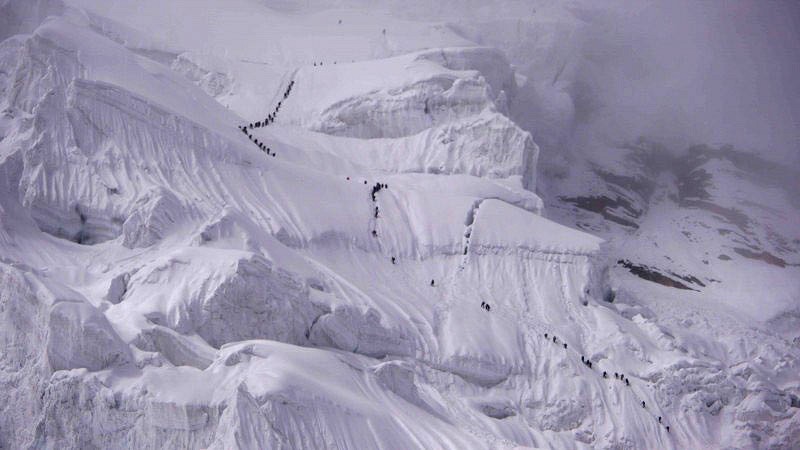
Remy Lecluse - by Alison Culshaw
I have a picture on my kitchen wall of a beautiful snowy line on the Aiguille du Chardonnet. People often ask what the picture is of. I smile, think back to that memorable day, and tell the story.
I had a few days off in January 2010 so what did I do with them? I had some ski lessons; steep skiing with Rémy Lécluse, lessons that were so valuable at the time but little did I know then how precious they would be to me now.
When I first met Rémy for a coffee he made it very clear that if he was going to guide me on steep slopes I had to be prepared to ski his way or we weren't doing it. I was happy to buy into that. I told him that I didn't really have any specific objectives. I'd rather go and ski something I'd hadn't heard of to make the most of the time with him. I wanted an adventure and to learn along the way. I knew he understood exactly what I wanted to get from my couple of days skiing with him and could see ideas brewing.
Our first ski together was to be a "warm up" day to practice his techniques. A quick non-stop lap off the top bin at Les Grands Montets and he had enough time to make an assessment of me. Whilst he was checking out conditions through his binoculars, I was catching my breath. He asked me if I used to race, "yes" I replied proudly, pleased that he had observed that in my skiing so quickly. "And how many times did you crash in races?" I replied it was probably about 1 in 7. "When you ski these types of slopes with me you can never crash. It's not an option." The message was very clear.
Then off he went breaking trail up the Petite Aiguille Verte with me hanging in behind trying to pretend I was finding it easy. He taught me how to "crawl" up through the powder to make the uphill easier! We stood at the top of the face and he said "Right I want to see you do 5 turns between here and there without jump turning". I looked at him blankly, "without jumping?" "Yes" he replied, "You need to keep your skis on the snow". And so the learning began.
He spoke to me sternly when I forgot to stop above him. Sternly in a reassuring way; reassured that he was giving me 100% of his attention and that my safety was his main focus. After the Chevalier couloir and a warm down in the Chapeau couloir, I was following him back through the forest. He was doing hundreds of quick turns on a six pence down the track and I was cruising behind. He stopped and shouted "Do you think I'm doing all these turns for my benefit?" I guess not. I followed behind trying to copy. He worked me hard and he got results. When you got a compliment you had really earned it.
With the warm up day over I was delighted with what we achieved and what I had learnt but we still had the "adventure" day to come. Remy had some ideas of where we might go but nothing was set in stone. His flexible approach reassured me that he was responding to the conditions in front of him. Bring everything, be prepared to go anywhere. It wasn't until we skied down onto the Argentiere Glacier that he made a firm decision. "Let's go for the South East Couloir on the Chardonnet". "Where?" He explained. I looked at my watch. So we are going to go from here to the top of the Chardonnet today? I'm glad he's breaking trail. The conditions were perfect for skiing downhill; fresh untracked powder everywhere with little effect from the wind or sun. But it certainly made it hard work to go uphill; again I was crawling uphill behind him.
I didn't take a camera. I tend not too when I need to focus in the mountains. It's just another distraction. But the memories of the descent are still vivid in my mind. There was beautiful fresh powder all the way through the couloirs that twist between the huge red granite towers. Remy danced down effortlessly demonstrating exactly how he wanted me to ski. I tried to replicate it and I would hear him voice reminders when I didn't "don't jump" "double pole plant". He could fit turns in where I aspired too. Eventually we skied out the bottom of the couloir. I don't remember many stops between there and the Pierre a Ric Piste. We skied down the piste amongst the skiers that we had begun the day with. Glancing back up at the Chardonnet, I felt quietly privileged that our day had probably been quite different to theirs. All thanks to Rémy.
Rémy is renowned for his own personal achievements, but he also had a unique skill in guiding people in this environment too, teaching them and helping people to accomplish their goals. He was "the Godfather" of steep skiing in every way, but he was also just a really nice bloke to be around. It was always a pleasure to bump into him in the street or on the hill. He had time for everybody. I'll continue to aspire to dance down ski slopes with the fluidity that he did, and to coach my clients to do the same. Rémy Lécluse is the greatest loss to skiing I have ever known.
Rémy was initially missing following the avalanche on Manaslu 8156m on Sunday 23rd September but his body has now been found. He was with Glen Plake and Greg Costa, and they were attempting to be the first team to ski Manaslu without oxygen. Glen survived and Greg Costa is still missing, presumed dead.
This was first published on Alison's web site here.

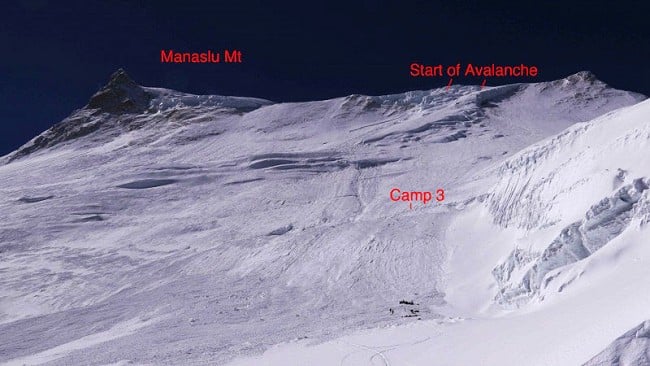
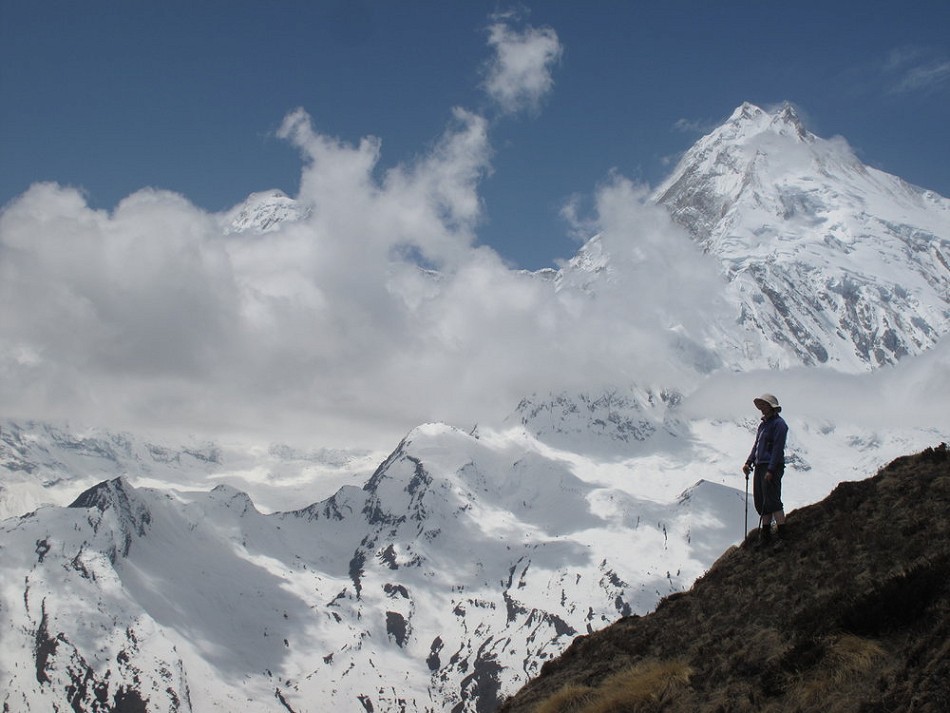





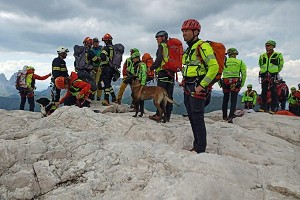
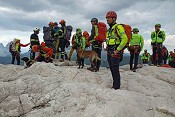
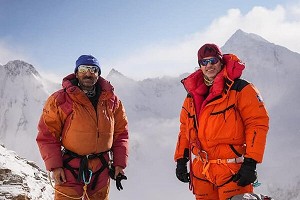



Comments